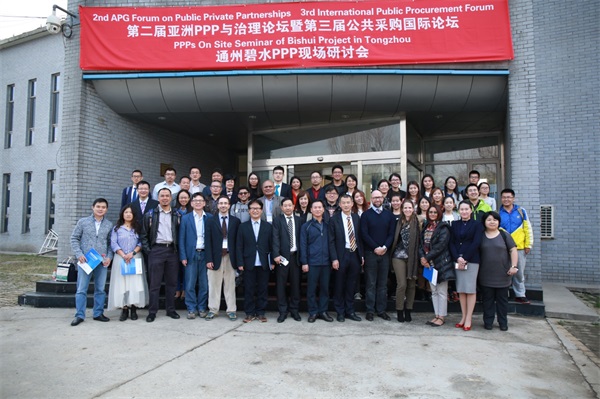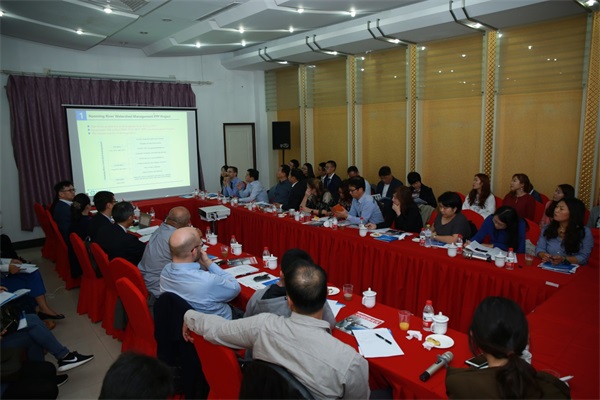The “PPPs On-Site Seminar of Bishui Project in Tongzhou” of the 2nd APG Forum On Public Private Partnerships & 3rd International Public Procurement Forum Sponsored by OECD was Successfully Held
2016-11-01 On the afternoon of Oct. 14, 2016, the “PPPs On-Site Seminar of Bishui Project in Tongzhou” of the 2nd APG Forum On Public Private Partnerships & 3rd International Public Procurement Forum successfully kicked off in Beijing. The seminar was co-sponsored by the Organisation for Economic Co-operation and Development (OECD), China Institute of Public Procurement at Central University of Finance and Economics, and Korea Legislation Research Institute, and convened at the Tongzhou Bishui Underground WWTP invested, constructed and operated by CWEG. At the seminar, CWEG Vice President Fang Yong made an address. CWEG Assistant Chairman Dr. Gan Lili delivered a keynote speech and shared the group’s PPP demonstration projects implemented in China and practices in PPP-based technical and model innovation.
As one of the event series of “China PPP Academy Week 2016” held by the Central University of Finance and Economics in collaboration with several Chinese and foreign institutions, in addition to attendees from South Korea, France, Canada and other OECD members, the seminar also brought together experts and representatives from Asian countries including China, India, Indonesia, Thailand, Vietnam, Mongolia, Malaysia, Bangladesh, the Philippines and Myanmar, as well as relevant international organizations. Themed on “Ensuring Successful PPPs for Asia’s Sustainable Development”, the seminar acted as a teller of China’s PPP stories and welcomed domestic and foreign experts’ investigation of PPP practices in China, showing China’s high confidence in its PPP model. Accompanied by CWEG Vice President Fang Yong, domestic and foreign expert attendees first visited the Bishui Underground WWTP, where they listened to the introduction made by CWEG Assistant Chairman Dr. Gan Lili.
Accompanied by CWEG Vice President Fang Yong, domestic and foreign expert attendees first visited the Bishui Underground WWTP, where they listened to the introduction made by CWEG Assistant Chairman Dr. Gan Lili.
Adopting the PPP model, the Bishui Project is at the core of the PPP demonstration project “Beijing-Tianjin-Hebei Integration: The North Canal Watershed Management”. Its purpose is to upgrade the original WWTP to a fully-enclosed underground one while ensuring the original WWTP’s compliance with discharge standards. Featuring the hardest-upgrade but the fastest-completion of its kind in China, the Bishui Project produces effluent meeting the highest discharge standard of China. It is the first example of successfully replacing the previously adopted international technology with China’s proprietary technology, and a benchmark project in transforming traditional WWTPs generally known as “negative assets” of cities into “positive assets”.

 After the visit, Professor Cao Fuguo at the Central University of Finance and Economics presided over the on-site seminar. He shared his experience of inspecting CWEG’s Guiyang Nanming River project and explained why the Bishui WWTP is chosen as the venue for the “PPPs On-Site Seminar”. CWEG Vice President Fang Yong introduced China""s water environment management policies and the development and achievements of PPP projects in China, expressing his intention to bring China""s PPP reform forward through international cooperation. CWEG Assistant Chairman Dr. Gan Lili gave detailed introductions about CWEG’s Bishui Project, Guiyang Nanming River Project, Yunan Dali Erhai Lake Project, Sichuan Guang’an “Clean Water Action” Project, and etc.
After the visit, Professor Cao Fuguo at the Central University of Finance and Economics presided over the on-site seminar. He shared his experience of inspecting CWEG’s Guiyang Nanming River project and explained why the Bishui WWTP is chosen as the venue for the “PPPs On-Site Seminar”. CWEG Vice President Fang Yong introduced China""s water environment management policies and the development and achievements of PPP projects in China, expressing his intention to bring China""s PPP reform forward through international cooperation. CWEG Assistant Chairman Dr. Gan Lili gave detailed introductions about CWEG’s Bishui Project, Guiyang Nanming River Project, Yunan Dali Erhai Lake Project, Sichuan Guang’an “Clean Water Action” Project, and etc.
 The PPP projects of CWEG, due to technical and model innovation, attracted wide interest from domestic and foreign expert attendees. They raised questions, and then had discussions enthusiastically. Representatives from Vietnam, India, the Philippines, Mongolia and other Asian countries also expressed their strong desire to deepen cooperation with CWEG.
The PPP projects of CWEG, due to technical and model innovation, attracted wide interest from domestic and foreign expert attendees. They raised questions, and then had discussions enthusiastically. Representatives from Vietnam, India, the Philippines, Mongolia and other Asian countries also expressed their strong desire to deepen cooperation with CWEG.
As one of the event series of “China PPP Academy Week 2016” held by the Central University of Finance and Economics in collaboration with several Chinese and foreign institutions, in addition to attendees from South Korea, France, Canada and other OECD members, the seminar also brought together experts and representatives from Asian countries including China, India, Indonesia, Thailand, Vietnam, Mongolia, Malaysia, Bangladesh, the Philippines and Myanmar, as well as relevant international organizations. Themed on “Ensuring Successful PPPs for Asia’s Sustainable Development”, the seminar acted as a teller of China’s PPP stories and welcomed domestic and foreign experts’ investigation of PPP practices in China, showing China’s high confidence in its PPP model.

Adopting the PPP model, the Bishui Project is at the core of the PPP demonstration project “Beijing-Tianjin-Hebei Integration: The North Canal Watershed Management”. Its purpose is to upgrade the original WWTP to a fully-enclosed underground one while ensuring the original WWTP’s compliance with discharge standards. Featuring the hardest-upgrade but the fastest-completion of its kind in China, the Bishui Project produces effluent meeting the highest discharge standard of China. It is the first example of successfully replacing the previously adopted international technology with China’s proprietary technology, and a benchmark project in transforming traditional WWTPs generally known as “negative assets” of cities into “positive assets”.



 中国水环境集团
中国水环境集团









